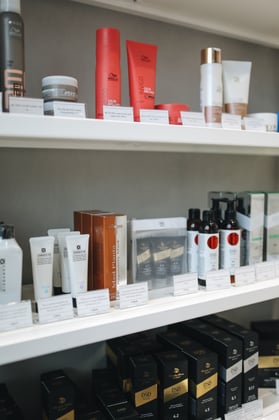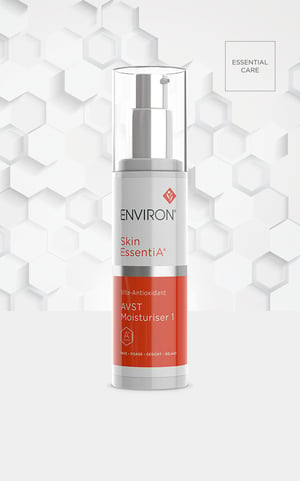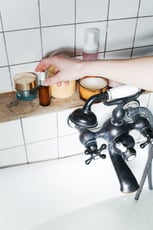What Products to Use with Retin-A (Tretinoin)
When I started on my journey with Retin-A (otherwise known by its generic name, tretinoin), I was...


When I went to get a Hydrafacial a few months ago (read my review) my esthetician recommended that I start using a Vitamin A product, aka a retinoid. As most people with sensitive acne-prone skin would probably feel, I was immediately nervous. I'd heard the horror stories of peeling, dry, flaky, red skin from using retinoids like Retin-A, Differin, and other common products. In fact, I'd even tried Retin-A years ago and had suffered the quintessential redness and flakiness for a few days before swearing off it completely and throwing it in the trash.
But as I learned, there is more than one type of retinoid, and not all of them are alike. In this post, I'll break down each type of retinoid, what they're meant for, and how to use a retinoid on sensitive acne-prone skin like mine. I'll also give a review of the current retinoid I've been using for the last few months and the results I've seen so far.
Retinoids are Vitamin A derivatives, which come in both over the counter and prescription formats.
Retinoids are often recommended for anti-aging, but they are also amazing for acne. They work to treat acne by:
They also help slow down collagen loss which can bolster the skin's thickness and elasticity, hence its anti-aging properties.
Retinoids can be categorized by how close they are to retinoic acid, which is the form our skin most readily absorbs. A product that's pure retinoic acid can be absorbed immediately, whereas other products need to be converted into retinoic acid first before they can be absorbed. This conversion process lessens their intensity and effectiveness, which can also decrease the potential for irritation.
(These are all retinoic acid derivatives, so they don't require a conversion process in the skin to be absorbed!)
*Differin is also available in low concentrations over the counter at places like Target.
In summary, the most irritating retinoids are also the most effective ones: tretinoin, adapalene, and tazarotene. For over the counter options, retinol is the most effective but also has the highest potential for irritation. Retinaldehyde, retinyl esters, and retinyl retinoate are all less prone to irritation, but also less effective.
If your skin is sensitive, it's best to start with a less potent form of Vitamin A that requires a 2-step conversion to retinoic acid, such as retinyl palmitate or retinyl retinoate. These products have a much lower chance of irritating your skin than high-potency ones.
If your main concern is acne and your skin isn't very sensitive, or if you've used retinoids in the past, then you might benefit from adapalene, which is most commonly found under the brand name Differin. (Disclaimer: I haven't used Differin myself so I can't speak to its effectiveness or any side effects.)
Whichever product you decide to use, make sure that it's packaged properly. Vitamin A is an unstable ingredient, especially when exposed to air or light. So make sure that your product comes in opaque, airless packaging. Any retinoid that comes in a tub that's exposed to air, or a clear glass bottle exposed to light is probably going to be ineffective.
Once you've chosen a product, start by patch-testing it on a small area of your face such as your jaw. If you don't experience any adverse reactions, start using it every 3 nights, working your way up to every other night, then every night if your skin can tolerate it. With any active ingredient, it's best to start slow to see if your skin will have a reaction or not.
There is also the option of buffering your retinoid. This involves applying moisturizer before your retinoid to create a buffer between your skin and the active ingredient. This is a good option if you have sensitive skin, especially if you want to use a more potent retinoid such as Differin or Retin-A.
It is possible to use retinoids during the day, but since they have sun-sensitizing properties it's best to use them at night to be safe. Make sure that you're extra diligent and wear sunscreen every day when you're using a retinoid!
The rentoid that I decided to start with is the Environ Skin EssentiA Vita-Antioxidant AVST Moisturizer 1, which is the lowest concentration they offer. (Link to product website) It cost $75 at my local medical spa.

The version of Vitamin A in this product is retinyl palmitate, which is one of the least effective retinoids and also the least irritating. It's pretty far down the ingredient list, so it's at a very low concentration in this particular product - this is what I was recommended to start with, given that my sensitive acne-prone skin can be reactive and unpredictable.
This moisturizer is extremely lightweight and has a slight yellowish color that disappears once applied. Since my skin is on the dry side, I wouldn't consider this moisturizing enough for me alone, so I follow it up with one of my richer night creams and/or a facial oil after letting it sink in for a few minutes.
I started off by patch testing, then applying it every 3 nights, then every other night. For the past month or so, I've been applying it every night and haven't had any adverse reactions!
This moisturizer comes in an opaque bottle with a pump, so it's protected from air and light which would ruin the retinoid's effectiveness - A+ on packaging!
I was surprised by how well my skin tolerated this product, though now that I know as much as I do about retinoids it makes sense. This particular retinoid is very well suited for sensitive skin - I never experienced any negative side effects such as dryness, flakiness, or redness.
However, I have seen some pretty good results from using this product regularly over the past couple months. It hasn't necessarily prevented or treated my breakouts, but I have noticed that my skin bounces back much faster after a breakout. My redness and scarring are reduced quicker, which is likely due to the fact that retinoids increase cell turnover and essentially thicken the skin.
Aside from breakouts, my skin texture has definitely improved. My skin is smoother than it's been in a while and is starting to get that "glass skin" look that I'm going for. I can tell that I'll eventually need to up my concentration to a higher level, or move to a more potent form of Vitamin A to see the dramatic results that I want, but this is definitely a good "starter retinoid."
After several months of using this retinol, I decided to move up to the big leagues and got a prescription from my dermatologist for Retin-A. I started with the lowest concentration, 0.025%, and wrote about my experience in this blog post.

Hi, I'm Rachel! Welcome to my blog.


When I started on my journey with Retin-A (otherwise known by its generic name, tretinoin), I was...


I may be a little late in the game, but I've recently become obsessed with Korean beauty (or...
Leave a Comment